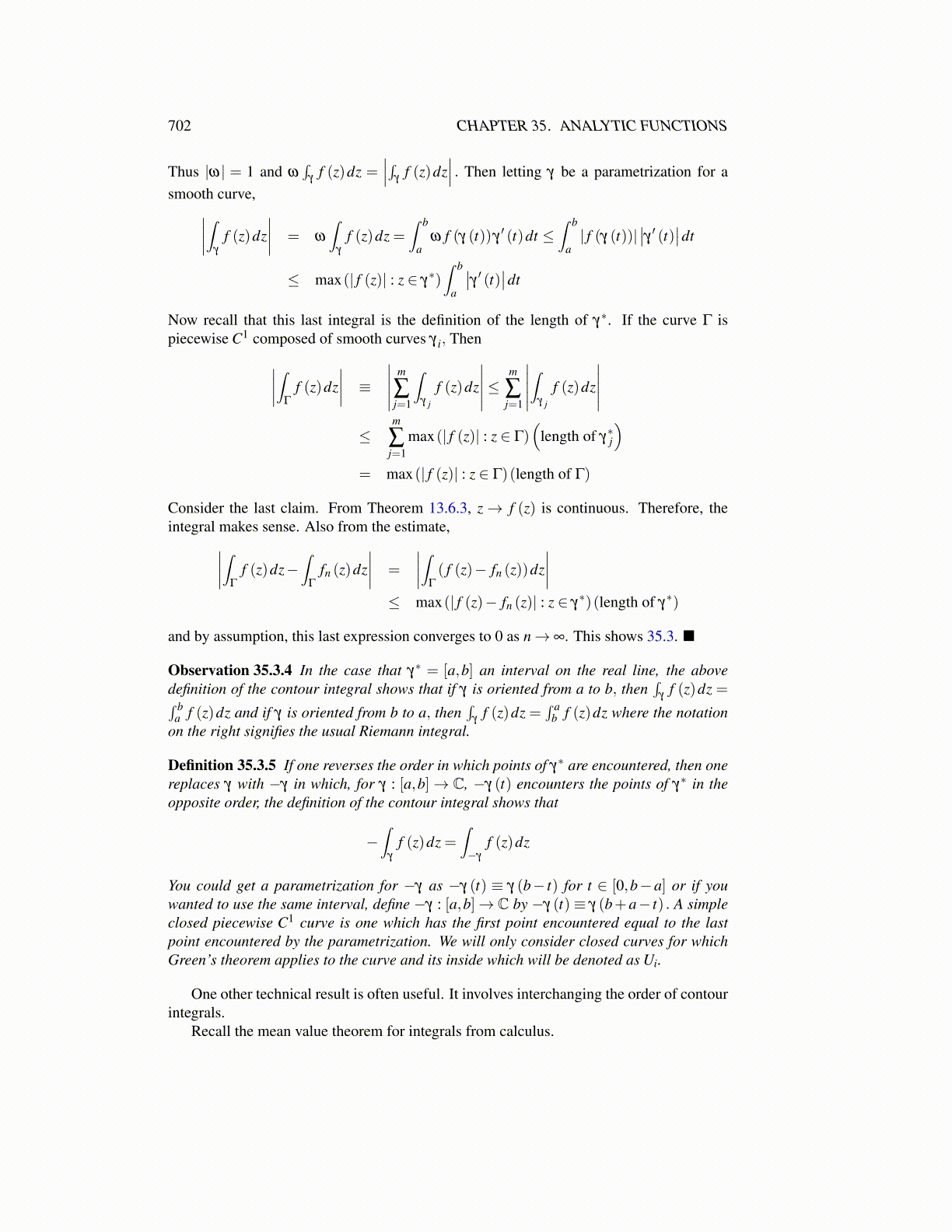
702 CHAPTER 35. ANALYTIC FUNCTIONS
Thus |ω| = 1 and ω∫
γf (z)dz =
∣∣∣∫γf (z)dz
∣∣∣ . Then letting γ be a parametrization for asmooth curve,∣∣∣∣∫
γ
f (z)dz∣∣∣∣ = ω
∫γ
f (z)dz =∫ b
aω f (γ (t))γ
′ (t)dt ≤∫ b
a| f (γ (t))|
∣∣γ ′ (t)∣∣dt
≤ max(| f (z)| : z ∈ γ∗)∫ b
a
∣∣γ ′ (t)∣∣dt
Now recall that this last integral is the definition of the length of γ∗. If the curve Γ ispiecewise C1 composed of smooth curves γ i, Then∣∣∣∣∫
Γ
f (z)dz∣∣∣∣ ≡
∣∣∣∣∣ m
∑j=1
∫γ j
f (z)dz
∣∣∣∣∣≤ m
∑j=1
∣∣∣∣∣∫
γ j
f (z)dz
∣∣∣∣∣≤
m
∑j=1
max(| f (z)| : z ∈ Γ)(
length of γ∗j
)= max(| f (z)| : z ∈ Γ)(length of Γ)
Consider the last claim. From Theorem 13.6.3, z→ f (z) is continuous. Therefore, theintegral makes sense. Also from the estimate,∣∣∣∣∫
Γ
f (z)dz−∫
Γ
fn (z)dz∣∣∣∣ =
∣∣∣∣∫Γ
( f (z)− fn (z))dz∣∣∣∣
≤ max(| f (z)− fn (z)| : z ∈ γ∗)(length of γ
∗)
and by assumption, this last expression converges to 0 as n→ ∞. This shows 35.3. ■
Observation 35.3.4 In the case that γ∗ = [a,b] an interval on the real line, the abovedefinition of the contour integral shows that if γ is oriented from a to b, then
∫γ
f (z)dz =∫ ba f (z)dz and if γ is oriented from b to a, then
∫γ
f (z)dz =∫ a
b f (z)dz where the notationon the right signifies the usual Riemann integral.
Definition 35.3.5 If one reverses the order in which points of γ∗ are encountered, then onereplaces γ with −γ in which, for γ : [a,b]→ C, −γ (t) encounters the points of γ∗ in theopposite order, the definition of the contour integral shows that
−∫
γ
f (z)dz =∫−γ
f (z)dz
You could get a parametrization for −γ as −γ (t) ≡ γ (b− t) for t ∈ [0,b−a] or if youwanted to use the same interval, define −γ : [a,b]→ C by −γ (t)≡ γ (b+a− t) . A simpleclosed piecewise C1 curve is one which has the first point encountered equal to the lastpoint encountered by the parametrization. We will only consider closed curves for whichGreen’s theorem applies to the curve and its inside which will be denoted as Ui.
One other technical result is often useful. It involves interchanging the order of contourintegrals.
Recall the mean value theorem for integrals from calculus.